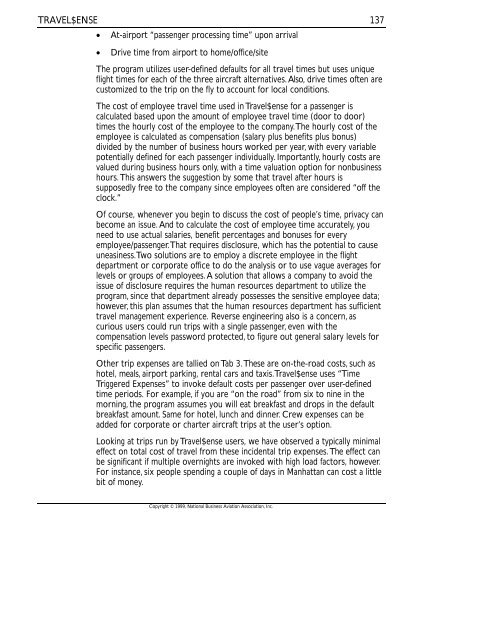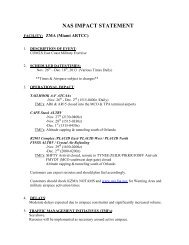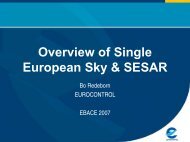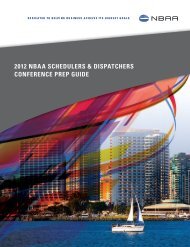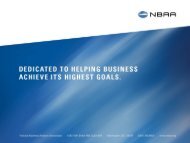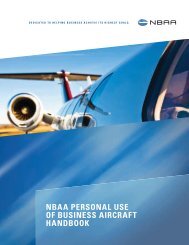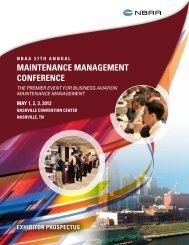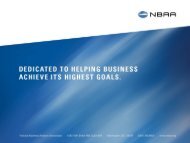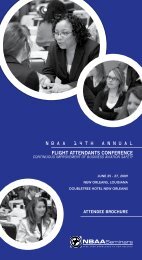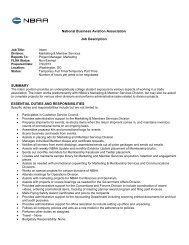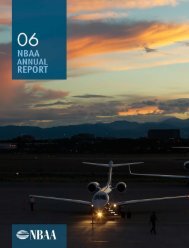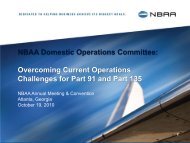Travel$ense User's Guide (PDF, 139 MB) - NBAA
Travel$ense User's Guide (PDF, 139 MB) - NBAA
Travel$ense User's Guide (PDF, 139 MB) - NBAA
- No tags were found...
Create successful ePaper yourself
Turn your PDF publications into a flip-book with our unique Google optimized e-Paper software.
TRAVEL$ENSE• At-airport “passenger processing time” upon arrival137• Drive time from airport to home/office/siteThe program utilizes user-defined defaults for all travel times but uses uniqueflight times for each of the three aircraft alternatives. Also, drive times often arecustomized to the trip on the fly to account for local conditions.The cost of employee travel time used in <strong>Travel$ense</strong> for a passenger iscalculated based upon the amount of employee travel time (door to door)times the hourly cost of the employee to the company. The hourly cost of theemployee is calculated as compensation (salary plus benefits plus bonus)divided by the number of business hours worked per year, with every variablepotentially defined for each passenger individually. Importantly, hourly costs arevalued during business hours only, with a time valuation option for nonbusinesshours. This answers the suggestion by some that travel after hours issupposedly free to the company since employees often are considered “off theclock.”Of course, whenever you begin to discuss the cost of people’s time, privacy canbecome an issue. And to calculate the cost of employee time accurately, youneed to use actual salaries, benefit percentages and bonuses for everyemployee/passenger. That requires disclosure, which has the potential to causeuneasiness. Two solutions are to employ a discrete employee in the flightdepartment or corporate office to do the analysis or to use vague averages forlevels or groups of employees. A solution that allows a company to avoid theissue of disclosure requires the human resources department to utilize theprogram, since that department already possesses the sensitive employee data;however, this plan assumes that the human resources department has sufficienttravel management experience. Reverse engineering also is a concern, ascurious users could run trips with a single passenger, even with thecompensation levels password protected, to figure out general salary levels forspecific passengers.Other trip expenses are tallied on Tab 3. These are on-the-road costs, such ashotel, meals, airport parking, rental cars and taxis. <strong>Travel$ense</strong> uses “TimeTriggered Expenses” to invoke default costs per passenger over user-definedtime periods. For example, if you are “on the road” from six to nine in themorning, the program assumes you will eat breakfast and drops in the defaultbreakfast amount. Same for hotel, lunch and dinner. Crew expenses can beadded for corporate or charter aircraft trips at the user’s option.Looking at trips run by <strong>Travel$ense</strong> users, we have observed a typically minimaleffect on total cost of travel from these incidental trip expenses. The effect canbe significant if multiple overnights are invoked with high load factors, however.For instance, six people spending a couple of days in Manhattan can cost a littlebit of money.Copyright © 1999, National Business Aviation Association, Inc.


